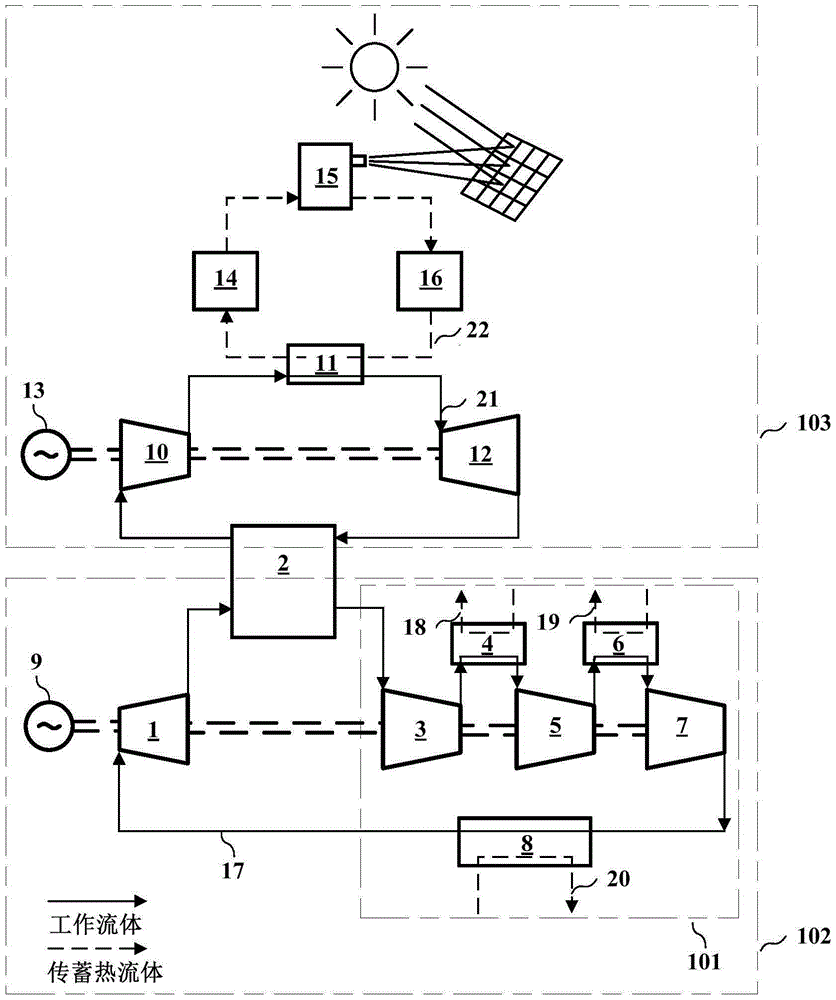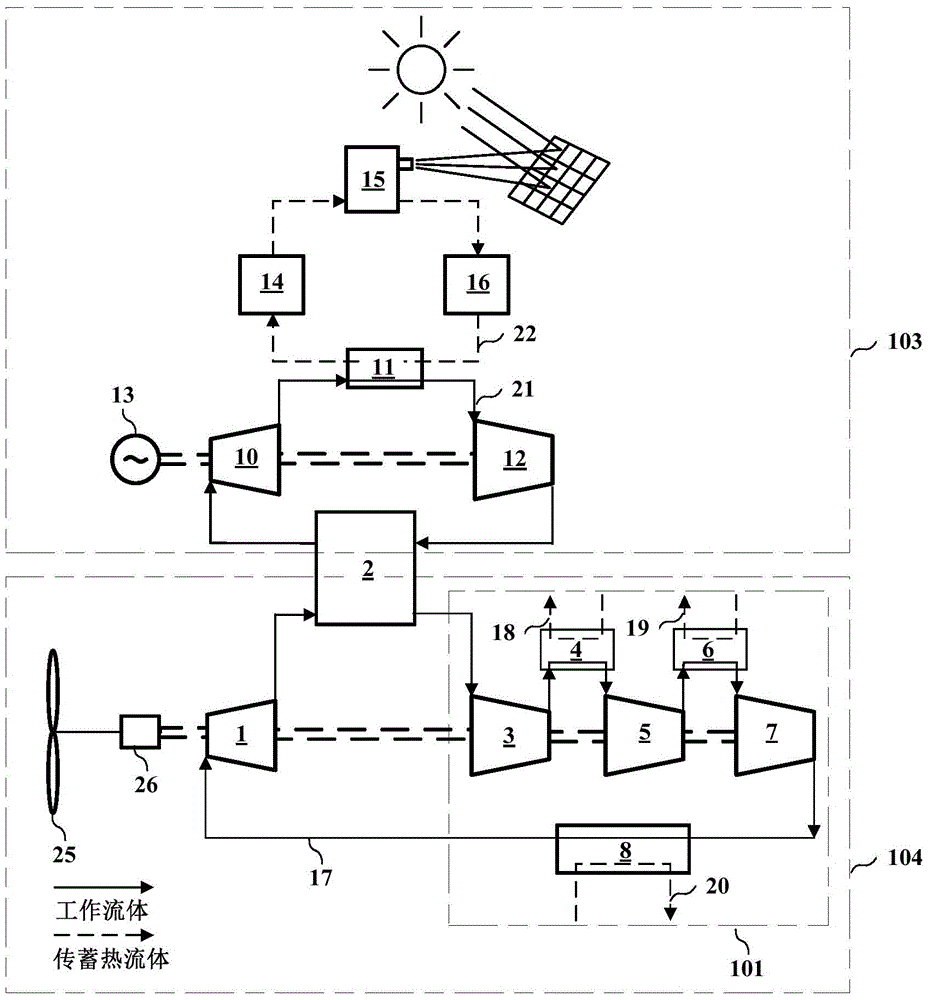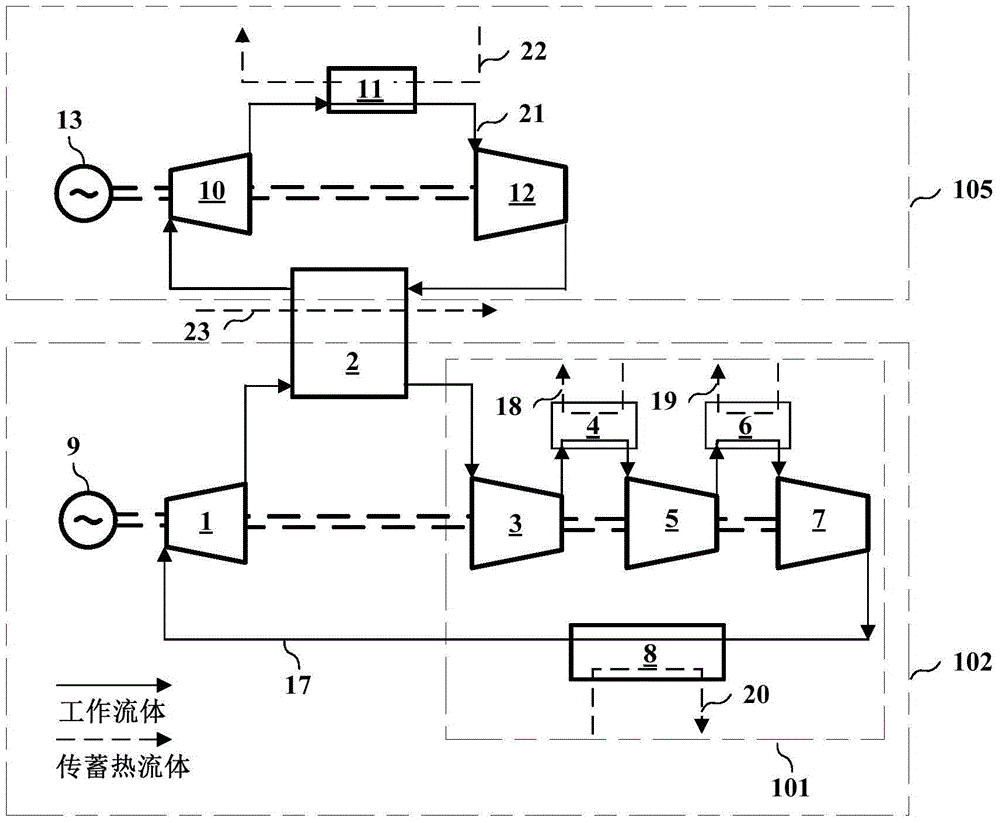System for storing electric energy by means of low-temperature cold energy and operating method of system
An energy storage system and cold energy technology, applied in the direction of energy storage, greenhouse gas reduction, heat storage equipment, etc., can solve the problems of low energy storage conversion efficiency, adverse effects of power grid, instability, etc., and achieve high conversion efficiency and use The effect of long life and low cost
- Summary
- Abstract
- Description
- Claims
- Application Information
AI Technical Summary
Problems solved by technology
Method used
Image
Examples
Embodiment 1
[0046] like figure 1 Shown is Embodiment 1 of the system for storing electric energy with low-temperature cold energy of the present invention, including an energy storage circuit 102, an energy release circuit 103 and a solar heat storage subsystem.
[0047] figure 1 The energy storage circuit shown includes: expander 1, cold energy storage 2, first-stage compressor 3, first-stage compressor heat exchanger 4, second-stage compressor 5, and second-stage compressor heat exchanger 6 , The third stage compressor 7 and the third stage compressor heat exchanger 8. Working gas such as figure 1 Cycle through these components as indicated by the solid lines with arrows in . The rotating shaft of the electric motor 9 is connected with the rotating shafts of the expander 1 and the compressors 3, 5, 7. Furthermore, cooling liquids 18, 19, 20 are connected in heat exchangers 4, 6, 8, respectively.
[0048] The operation process of the energy storage cycle is as follows: firstly, the ...
Embodiment 2
[0053] like figure 2 Shown is Embodiment 2 of the system of low-temperature cold energy storage electric energy coupled with wind power generation of the present invention, including an energy storage loop 104, an energy release loop 103 and a solar heat storage subsystem.
[0054] figure 2 The energy storage circuit 104 shown includes: an expander 1, a cold storage 2, a first-stage compressor 3, a first-stage compressor heat exchanger 4, a second-stage compressor 5, and a second-stage compressor heat exchanger 6. The third stage compressor 7 and the third stage compressor heat exchanger 8. Working gas such as figure 1 Cycle through these components as indicated by the solid lines with arrows in . The wind wheel 25 of the wind power generation system is connected with a gearbox 26 , and the rotating shaft of the gearbox 26 is connected with the rotating shafts of the expander 1 and the compressors 3 , 5 , and 7 . Furthermore, cooling liquids 18, 19, 20 are connected in h...
Embodiment 3
[0057] like image 3 Shown is Embodiment 3 of the system in which low-temperature cold energy storage electrical energy is coupled with industrial waste heat and waste cold energy according to the present invention, including an energy storage circuit 102 and an energy release circuit 105 .
[0058] The gas circulation during the energy storage cycle of embodiment 3 is the same as the energy storage cycle of embodiment 1. In the energy storage cycle, the work done by the motor 9 and the expander 1 jointly drives the compressor unit 101 to run, and the electric energy consumed is the difference between the power consumed by the compressor and the work produced by the expander, and what is stored is the cold energy in the cold storage 2 . In addition, during the energy storage cycle and the interval of charging / discharging, the industrial residual cold fluid 23 from liquefied natural gas or air separation system enters the cold energy storage 2, and the low-temperature cold ene...
PUM
 Login to View More
Login to View More Abstract
Description
Claims
Application Information
 Login to View More
Login to View More - R&D
- Intellectual Property
- Life Sciences
- Materials
- Tech Scout
- Unparalleled Data Quality
- Higher Quality Content
- 60% Fewer Hallucinations
Browse by: Latest US Patents, China's latest patents, Technical Efficacy Thesaurus, Application Domain, Technology Topic, Popular Technical Reports.
© 2025 PatSnap. All rights reserved.Legal|Privacy policy|Modern Slavery Act Transparency Statement|Sitemap|About US| Contact US: help@patsnap.com



